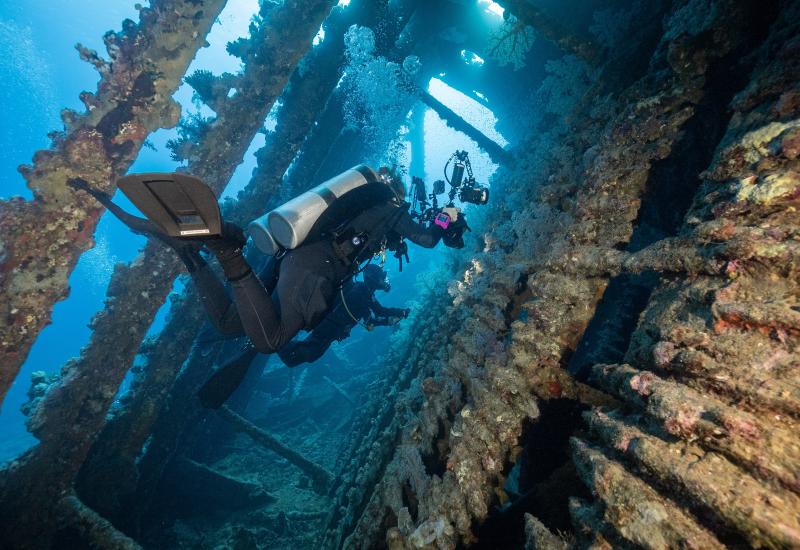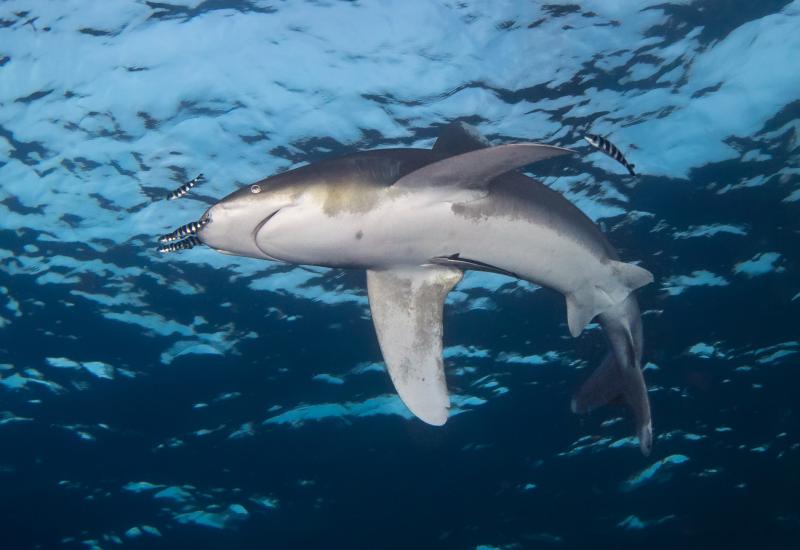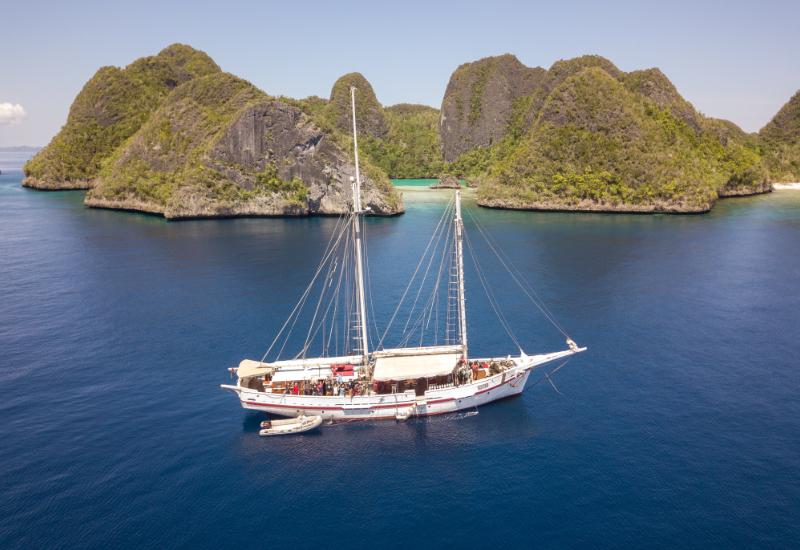Exploring the Reefs, Corals, Wrecks and Walls of Egypt's Red Sea
Giant stride into the Egyptian Red Sea and everywhere you look, on every dive you make, is a mind-boggling concentration of marine life. Large numbers of reef fish amass in swirling schools and an astonishing variety of coral and sponge species plaster every reef. Big pelagics like dolphins and sharks patrol deep wrecks and walls. As European divers have long known, it's off-the-chart diving — one of the planet's richest marine ecosystems in a sea that's landlocked by desert on every side.
Bordered by seven countries, the Red Sea is a cleft of deep blue water formed millions of years ago when the Arabian Peninsula split from North Africa and the Indian Ocean flooded the basin from a small opening at its southern end. It's relatively isolated and with little freshwater flowing in, the 1,200-mile-long sea is saltier than most other bodies of water and features eccentric and colorful twists on Indo-Pacific marine life.
Whether you go north or south on a live-aboard boat in the Egyptian Red Sea, you can dive a diverse range of habitats. A northern itinerary offers wrecks and deep walls while a southern one boasts beautiful reefs and coral seamounts. The choice is yours.
Southern Itinerary
By Stephen Frink
When I first visited the Red Sea 1982, there was only one resort hotel in Sharm el Sheikh and one live-aboard, and some of the diving was done from seaside tents equipped with portable compressors and accessed via camel. Fast forward a quarter century and the diving infastructure in the Red Sea is greatly changed. But what hasn't changed is how very special it is.
For this trip, I booked the MV Hurricane, a 120-foot steel-hulled dive yacht. The itinerary — the owners have dubbed it "Simply the Best" — is a one-week trip to three different offshore islands in the southern Red Sea. After arrival at Marsa Alam's modern airport, we take a 10-minute ride in an air-conditioned motor coach to the huge marina development at Port Ghalib. This is an area that is experiencing growth — all around, we could see signs of new resort construction — and sun-worshipping Europeans will soon discover these beaches in greater numbers. But for now, Port Ghalib is a jumping-off point for dive adventure.
We spend a night in port and then steam offshore early the next day. To get our weights dialed in for the slightly saltier and more buoyant Red Sea, we make a checkout dive at a coastal site called Um el Rus. Because it's so close to shore, the visibility is good, though not great. At first glance, Um el Rus seems uninspiring, but typical of Red Sea diving, the marine life is fascinating. Pufferfish rest in the sand and scores of cornetfish are in the shallows. Blue-cheek butterflyfish, endemic to the Red Sea, capture the attention of the photographers onboard. These butterflyfish are among the most docile of Red Sea reef dwellers, so we all manage to get close and take quality images.
Elphinstone Reef
Several hours farther offshore brings us here, which is within range of Marsa Alam day boats and offers our first glimpse of the stellar water clarity the Red Sea is renowned for. The lack of rainfall prevents freshwater runoff from degrading water clarity at Elphinstone Reef. The vis is impressive even at the surface, as the oblong-shaped reef comes to within a few feet of the surface and drops precipitously on every side.
While Elphinstone is often fairly busy, visited by both live-aboards and day boats, this morning we have the north end of the reef to ourselves. You can dive to an archway at 160 feet where you can encounter patrolling thresher and hammerhead sharks. We stay shallow, however, and are entertained by a large school of anthias, large crimson squirrelfish, masked butterflyfish, and a resident Napoleon wrasse eager to pose. The highlight of the dive comes not along the wall but at the bow of the boat where a very curious (or reasonably aggressive) oceanic white-tip makes very close passes at a snorkeler wearing yummy-looking yellow fins. September through April is considered oceanic white-tip season here, so to see one so close when we were there — in July — is lucky.
After a full day diving at Elphinstone, we begin our overnight steam north to one of the truly iconic Red Sea gems, the Brothers Islands.
The Brothers Islands
These spectacular islands, known in Arabic as El Akhawein, are accessible only by live-aboard and are subject to both wind and current. Because they're exposed to current-swept nutrients, Big Brother (marked by a lighthouse) and Little Brother are magnificently draped in soft corals. In fact, the combination of crystalline blue water and soft coral concentrations makes the Brothers one of the world's best wide-angle studios. But it's not just about the reef scenics, for both islands present excellent opportunities for encounters with big pelagics and abundant reef fish.
We start off at Little Brother and find clear water and massive gorgonian fans decorating the vertical wall and reef slope down to 90 feet and beyond. Because of current, only the west side of the island is in the lee, but I have dived the east on a previous expedition and found it similarly remarkable. Some of the divers followed a deeper profile and are rewarded with a school of 12 hammerheads at 120 feet. After three dives at Little Brother, we move to our nighttime anchorage at Big Brother.
While this island offers plenty of vertical walls dripping with color and texture, its highlights are two shipwrecks lying along the deep slope of the wall. The Aida, the deeper of the two, sank in 1958. Technical divers can penetrate the wreck and explore her bow. Though recreational divers can see a bit of her at 100 to 120 feet, to really sample her treasures, you have to dive to at least 130 feet. That's too little time and too much nitrogen for me, and besides, the shallower Numidia is one of my all-time favorite wrecks.
The current is truly ripping on the Numidia. On days of heavy flow the only way to get to the wreck is to drop in from an inflatable boat up current, beat fins to 100 feet, and drift into the wreck. On our first drop we're put into the water down current, and there's no way we can fight our way back to the wreck. We drift to the wall and find spectacular wide-angle vistas.
On our second attempt the drop is fine, but the current is still so swift we have to dump air from our BCs and swim straight to the depths. Even so, I barely avoid being swept past the wreck by catching the upright mast and make my way to the lee of the deck. Compared to my last visit, she's not nearly as encrusted with soft corals, maybe as the result of a big storm. She's still a great dive, but not the jaw-dropping confluence of crimson soft corals and schools of orange anthias that I remember from earlier visits. Still, she's a must-dive at the Brothers, and eminently worthy of exploration.
Daedalus Reef
This massive offshore island is the final gem in the Red Sea's offshore Triple Crown. It's slightly exposed at low tide and marked by a large lighthouse that's open to live-aboard guests.
Daedalus Reef is so big it's really a series of four or more distinct dives. In fact, we do seven dives here and never exhaust the possibilities. The boats moor seaward of the lighthouse dock, along the island's east side. A short dinghy ride brings us to the northwest end of the island. You can dive deep here, to 120 feet, where deep-water currents often attract hammerheads and even thresher sharks. We stick to the shallows where there are pristine hard corals dotting the drop-off, from 10 feet to 80 feet, and a unique pinnacle with a large mass of opal sweepers at the 80-foot mark.
Our second dive is off the southwest end of the island at Anemone City, which has a large concentration of anemone clusters, all with crimson mantles and occupied by large numbers of two-band anemonefish or Red Sea clownfish. The shallowest, and probably largest, cluster of anemones is in only 20 feet of water, and they punctuate the wall down to about 60 feet, enough anemones to occupy even our large group of active photographers.
On the boat during lunch we see several oceanic white-tips and a school of bottlenose dolphins swimming past. An oceanic white-tip also puts on a spectacular show during our overnight stay here as he zooms to the back of the boat to scoop up the shark-friendly detritus discarded from our evening meal.
Other highlights of Daedalus include a massive mushroom coral, at least three stories tall. Aside from the crowds of clownfish, you'll also see lots of hawksbill turtles. We see three or four every time we dive along the south face of the island.
Northern Itinerary
By Mark Evans
The northern Red Sea isn't renowned for its dramatic walls (apart from Ras Mohammed), pelagic sightings and ripping currents, but what the north does have is wrecks--and what wrecks they are. I recently took a group of first-time Red Sea divers on a live-aboard's northern itinerary, taking in the Thistlegorm, the Rosalie Moller and Ras Mohammed, all world-class sites. We flew into Hurghada, and then boarded an air-conditioned mini-bus to our home for the week, the 135-foot Blue Horizon.
The Rosalie Moller
First up on this trip is one of my all-time favorites, the Rosalie Moller, a 360-foot cargo vessel that was carrying Welsh coal when she was sunk by German bombers in 1941. She sits upright in 170 feet of generally murky water, and is basically intact with portholes in place. The Rosalie is an awesome dive by anyone's standards. The deck doesn't start until 100 to 105 feet, making this a dive for experienced divers, but those comfortable with dropping down a line in only 30 to 35 feet of vis are rewarded with a large wreck absolutely smothered in marine life. Silversides and glassfish swarm over the superstructure, often in such huge numbers they limit the visibility even further. Lionfish, trevally, jacks and tuna are also living life to the full on this veritable smorgasbord of food. Even using nitrox, time is limited here, but what time you do have on her is well worth the effort. This really is a full-on dive, and one hell of an intro to the Red Sea's wrecks.
The Thistlegorm
This ship, one of the world's most famous wrecks, was first discovered by the legendary Jacques-Yves Cousteau in 1956, 15 years after it was sunk by German bombers. The massive cargo vessel then lay untouched until the early 1990s, when it was rediscovered and became the jewel in the northern Red Sea's crown.
This is a large, impressive wreck — 423 feet long — but what makes her so appealing to divers is the depth. She sits in just 105 feet of water and reaches to within 50 feet, so you get plenty of bottom time to explore the valuable cargo of military hardware contained in her holds.
The Thistlegorm is an underwater museum with armored cars, Bedford trucks, BSA motorcycles, mobile generators, airplane wings, Lee Enfield rifles, rubber boots and hundreds of rounds of .303 ammunition inside the cavernous interior. On the deck you'll see coal trucks and water tenders that were for the two locomotives that were onboard. The massive explosion that tore the wreck in two was so powerful it blew the main engines into the air, and they landed on either side of the vessel. They now sit on the seabed upright — perfect props for photographers. Bren carriers, massive shells and boxes of smaller munitions, as well as the drive shaft, cleanly sheared off from the stern, are in the debris field between the two intact sections of the wreck.
Everything on board is slowly succumbing to the decades she has spent on the seabed, but the Thistlegorm is still an amazing sight to behold. Divers who have been exploring her for many years might be dismayed at her current condition, but for first-timers, she still has the ability to take their breath away. We complete three dives on her, including one at night, and many in the group immediately named her their best-ever wreck dive.
Kingston
We follow the dives on the Thistlegorm with one on a much older wreck, the SS Kingston. This steam-powered cargo ship ran aground on Shag Rock in 1881 and is now an integral part of the reef. The stern section is still intact, but after 10 minutes or so, you can thoroughly explore all there is to see, and then drift along the reef. This shallow system is predominantly made up of hard corals, with outcrops of soft corals, and it's home to all the usual Red Sea reef dwellers, in particular large shoals of yellow snapper and fusiliers. This pretty reef is popular, but next on our itinerary is another biggie — Shark and Yolanda Reefs in Ras Mohammed National Marine Park.
Ras Mohammed National Marine Park
Jacques-Yves Cousteau named Shark Reef one of his top 10 dives in the world, and its dramatic sheer wall is simply awe-inspiring. Hit it in July — as we did — and you are rewarded by huge shoals of bohar snapper, batfish, jacks, unicornfish and barracuda, which will allow you to approach very close. This swirling mass of marine life can bring in the predators, and we have a brief, but memorable, encounter with a solitary hammerhead shark. Previously, I have spent time out in the blue with hunting black-tip sharks as well. Even tiger sharks have been sighted on Shark Reef in recent years.
Even without the sharks or the large shoals, the impressive soft coral growth on the wall and in the saddle between Shark and Yolanda is enough to keep any diver busy, with its wide-ranging array of Red Sea reef species.
Yolanda Reef is named after a Cypriot cargo ship that ran aground in 1980 and then sank in stormy conditions. The vessel has since slipped into the abyss and lies in 650 feet of water, but its cargo of bathroom fixtures is in the shallows — toilets, bath tubs, rolls of linoleum and shower curtains have all been absorbed into the reef, and are smothered in marine growth. Even the captain's BMW is here, though the twisted mass is hard to make out as a car, save for a couple of wheels and tires and the clutch and brake pedals.
This site can be subject to some strong currents, making it best suited to more experienced divers, but it's simply one of the world's best wall dives.
Dunraven & Sha'ab Abu Nuhas Wrecks
We round out the week with three more wrecks, the Dunraven, Giannis D and Carnatic. The Dunraven, like the Kingston, was a steam-powered sailing vessel that ran aground in 1876, and it ended up nestled upside down on a sloping reef. The stern sits in 90 feet and the bow in 50 feet, and it's possible to swim virtually the entire length of the vessel inside the upturned hull, save for a section that has collapsed near the midships. There's plenty of light penetration, so a light isn't necessary, but it's worth taking one with you to pick out the prop shaft, boilers and engine workings.
Next we travel to Sha'ab Abu Nuhas, home of four of the Red Sea's most popular dives, the Kimon M, Giannis D, Carnatic and the Marcus/Chrisoula K. Our plan is to dive the latter three, but less-than-ideal weather conditions mean we have to settle for dives on the Giannis D and Carnatic.
The Giannis D was a Greek cargo ship that ran aground in 1983 and now lies running up a sloping reef from 75 to 80 feet at the stern and 50 feet at the bow. The midships is completely destroyed, twisted and shattered by years of strong tide and wave action, but the large stern is pretty much intact, offering plenty of penetration routes through the bridge, crew's quarters and into the engine room. The superstructure of the Giannis D reaches up to within 15 feet of the surface, so it's possible to conduct a lengthy multilevel dive and finish up doing your safety stop still exploring the wreck.
The final wreck of the trip is the Carnatic. This steam-powered sailing ship ran aground on Abu Nuhas in 1869 and subsequently broke in two, taking 27 passengers and crew to the seabed with her. Amazingly, both sections of the wreck ended up next to each other. Much of the decking has rotted away, leaving the coral-encrusted metal hull and main structure, which is by far the most photogenic in the northern Red Sea.
For North American divers, the distance to the Red Sea and cost to travel there can be prohibitive — but whether you choose a northern or southern itinerary, the diving is well worth it.
One Fish, Two Fish, 1,100 Fish ...
If you're used to the fish typically found on Caribbean reefs, you'll be blown away by the species and sheer numbers of Indo-Pacfic fish found on every reef, seamount and wreck in the Red Sea. More than 1,100 species are found here (about 10 percent of these are endemic).
Visiting the Red Sea
The Red Sea is never going to attract divers from the U.S. in as large numbers as it does from the UK and other European countries. But those American divers who do make the trip across the Pond are going to be shouting about it once they get home. The diving is well worth the effort to get to Egypt (for more on how to get to the Red Sea from North America, see In Depth, p. 89, section 2). Add in the fun and adventure of the Middle Eastern experience--visiting the Pyramids, sampling shisha (fruit-flavored tobacco smoked through a water pipe) and taking a camel ride--the Red Sea has a lot to offer divers of all levels, whatever their nationality.
InDepth
Getting There: For North Americans, UK tour operators take the hassle out of planning a Red Sea trip, negotiating discounts with hotels, live-aboard and land-based dive operators, and airlines. You'll most likely fly into one of London's airports, either Heathrow (LHR) or Gatwick (LGW), and then board a connecting flight to Egypt. Flights from London to Egypt depart from Gatwick, so you'll either fly into Gatwick from the U.S., or into Heathrow and take a shuttle bus to Gatwick. From London, nonstop flights are available to Hurghada (HRG), Sharm-el-Sheikh (SSH) and Marsa Alam (RMF). Flying nonstop from New York to Cairo (CAI) is a good option if you've planned an add-on excursion to Cairo, the Nile River or pyramids. For a list of Egyptian tour operators, go to touregypt.net.
Entry Documents: A passport valid for six months from your date of return and a 30-day tourist visa are required. To get one before your trip, contact the Egyptian Embassy in Washington, D.C. (egyptembassy.net) or the Egyptian Consulate nearest you (http://www.usembassy.gov/. It is possible for U.S. citizens to obtain a visa at any of the Egyptian ports of entry.
Operators: Red Sea Aggressor.
Climate & Water Conditions: Egypt has two main seasons: a mild winter from November to April and a hot summer from May to October. In the coastal regions, average air temperatures range from the 60s to 100 degrees or more in summer. Water temps range from the low 70s in winter to the low 80s in summer. Visibility is consistently stellar, around 100 feet, except during occasional plankton blooms. The water tends to be choppy, and count on drift diving on exposed seamounts and pinnacles. The dive season is year-round. Late spring and fall are good months to plan your trip, but the big pelagics are around in July and August.
Money Matters: Currency is the Egyptian pound (EGP). Generally, tip the live-aboard crew at the end of the week, roughly 10 percent of the cost of the charter. If you're spending any time on the Egyptian mainland, tipping — or what is known as baksheesh — is common. Tip taxi drivers only when he has rendered a service you find helpful. Porters and others should be tipped when bags are carried or room service is delivered. Carry a few one pound notes (Egyptian) at all times.
U.S. Safety: Check the U.S. Department of State web site at travel.state.gov for the most up-to-date travel warnings.
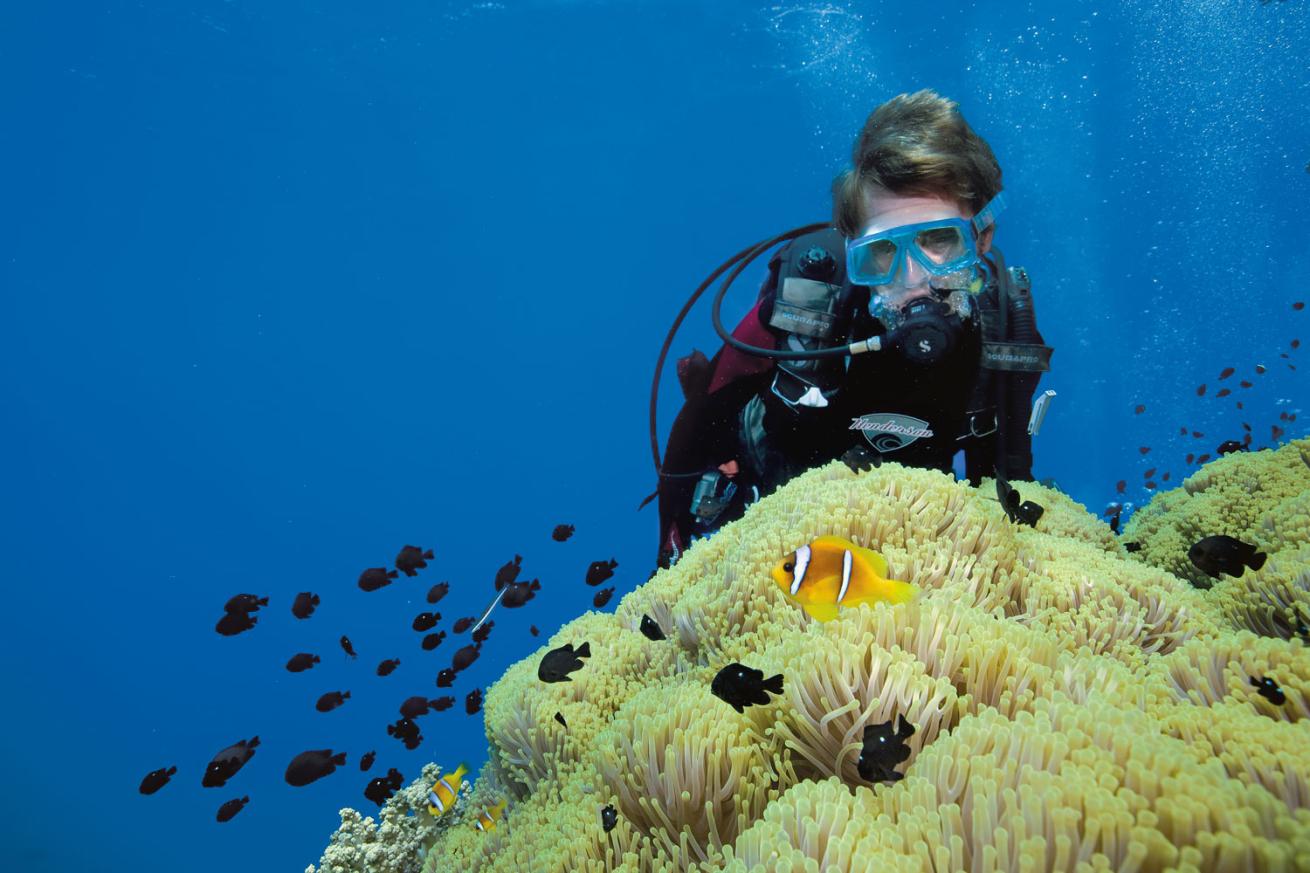
Stephen FrinkA two-band anemonefish at Anemone City on Daedalus Reef.
Giant stride into the Egyptian Red Sea and everywhere you look, on every dive you make, is a mind-boggling concentration of marine life. Large numbers of reef fish amass in swirling schools and an astonishing variety of coral and sponge species plaster every reef. Big pelagics like dolphins and sharks patrol deep wrecks and walls. As European divers have long known, it's off-the-chart diving — one of the planet's richest marine ecosystems in a sea that's landlocked by desert on every side.
Bordered by seven countries, the Red Sea is a cleft of deep blue water formed millions of years ago when the Arabian Peninsula split from North Africa and the Indian Ocean flooded the basin from a small opening at its southern end. It's relatively isolated and with little freshwater flowing in, the 1,200-mile-long sea is saltier than most other bodies of water and features eccentric and colorful twists on Indo-Pacific marine life.
Whether you go north or south on a live-aboard boat in the Egyptian Red Sea, you can dive a diverse range of habitats. A northern itinerary offers wrecks and deep walls while a southern one boasts beautiful reefs and coral seamounts. The choice is yours.
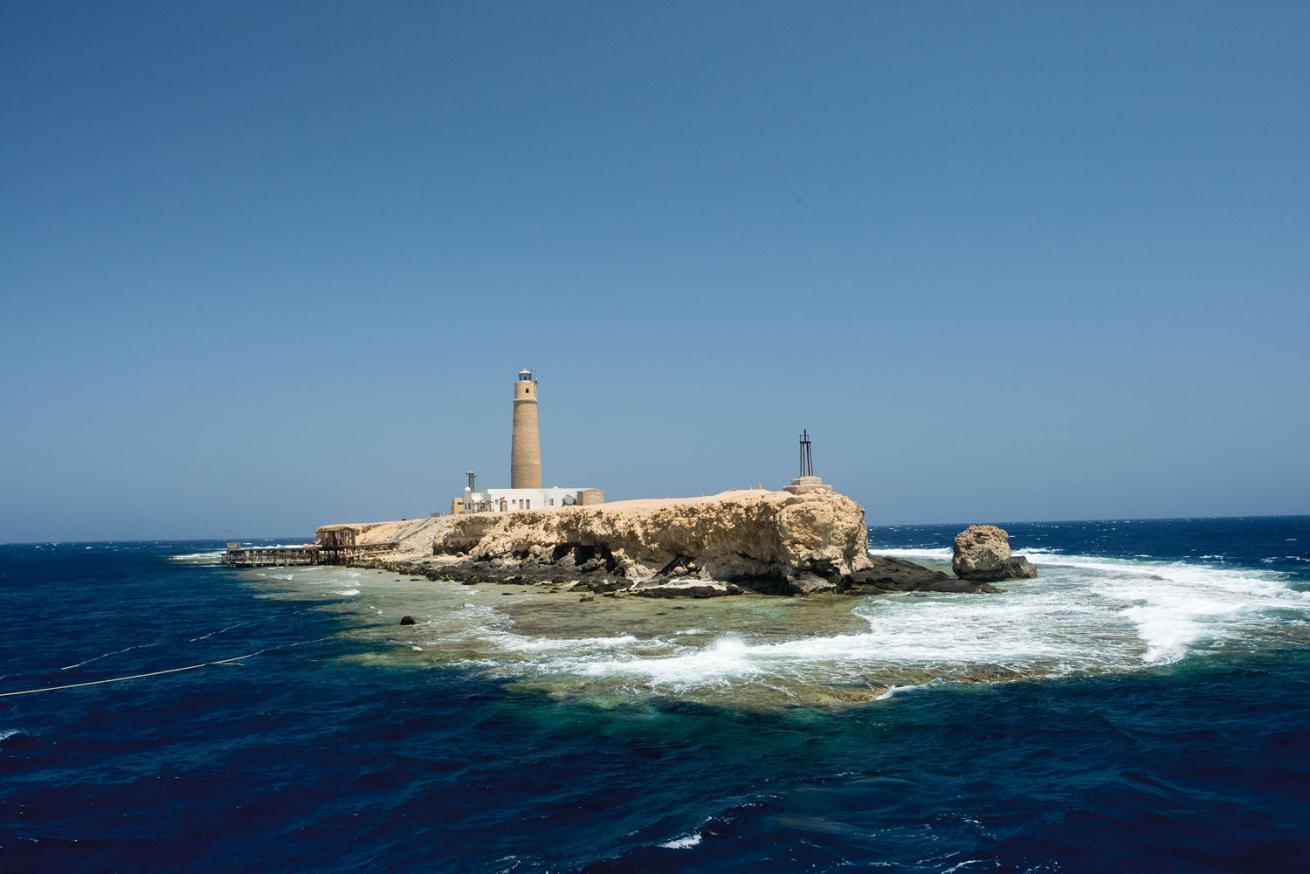
A large lighthouse has long marked Big Brother island, but that didn’t stop the Numidia and Aida from sinking here and providing world-class wreck dives as a result.
Southern Itinerary
By Stephen Frink
When I first visited the Red Sea 1982, there was only one resort hotel in Sharm el Sheikh and one live-aboard, and some of the diving was done from seaside tents equipped with portable compressors and accessed via camel. Fast forward a quarter century and the diving infastructure in the Red Sea is greatly changed. But what hasn't changed is how very special it is.
For this trip, I booked the MV Hurricane, a 120-foot steel-hulled dive yacht. The itinerary — the owners have dubbed it "Simply the Best" — is a one-week trip to three different offshore islands in the southern Red Sea. After arrival at Marsa Alam's modern airport, we take a 10-minute ride in an air-conditioned motor coach to the huge marina development at Port Ghalib. This is an area that is experiencing growth — all around, we could see signs of new resort construction — and sun-worshipping Europeans will soon discover these beaches in greater numbers. But for now, Port Ghalib is a jumping-off point for dive adventure.
We spend a night in port and then steam offshore early the next day. To get our weights dialed in for the slightly saltier and more buoyant Red Sea, we make a checkout dive at a coastal site called Um el Rus. Because it's so close to shore, the visibility is good, though not great. At first glance, Um el Rus seems uninspiring, but typical of Red Sea diving, the marine life is fascinating. Pufferfish rest in the sand and scores of cornetfish are in the shallows. Blue-cheek butterflyfish, endemic to the Red Sea, capture the attention of the photographers onboard. These butterflyfish are among the most docile of Red Sea reef dwellers, so we all manage to get close and take quality images.
Elphinstone Reef
Several hours farther offshore brings us here, which is within range of Marsa Alam day boats and offers our first glimpse of the stellar water clarity the Red Sea is renowned for. The lack of rainfall prevents freshwater runoff from degrading water clarity at Elphinstone Reef. The vis is impressive even at the surface, as the oblong-shaped reef comes to within a few feet of the surface and drops precipitously on every side.
While Elphinstone is often fairly busy, visited by both live-aboards and day boats, this morning we have the north end of the reef to ourselves. You can dive to an archway at 160 feet where you can encounter patrolling thresher and hammerhead sharks. We stay shallow, however, and are entertained by a large school of anthias, large crimson squirrelfish, masked butterflyfish, and a resident Napoleon wrasse eager to pose. The highlight of the dive comes not along the wall but at the bow of the boat where a very curious (or reasonably aggressive) oceanic white-tip makes very close passes at a snorkeler wearing yummy-looking yellow fins. September through April is considered oceanic white-tip season here, so to see one so close when we were there — in July — is lucky.
After a full day diving at Elphinstone, we begin our overnight steam north to one of the truly iconic Red Sea gems, the Brothers Islands.
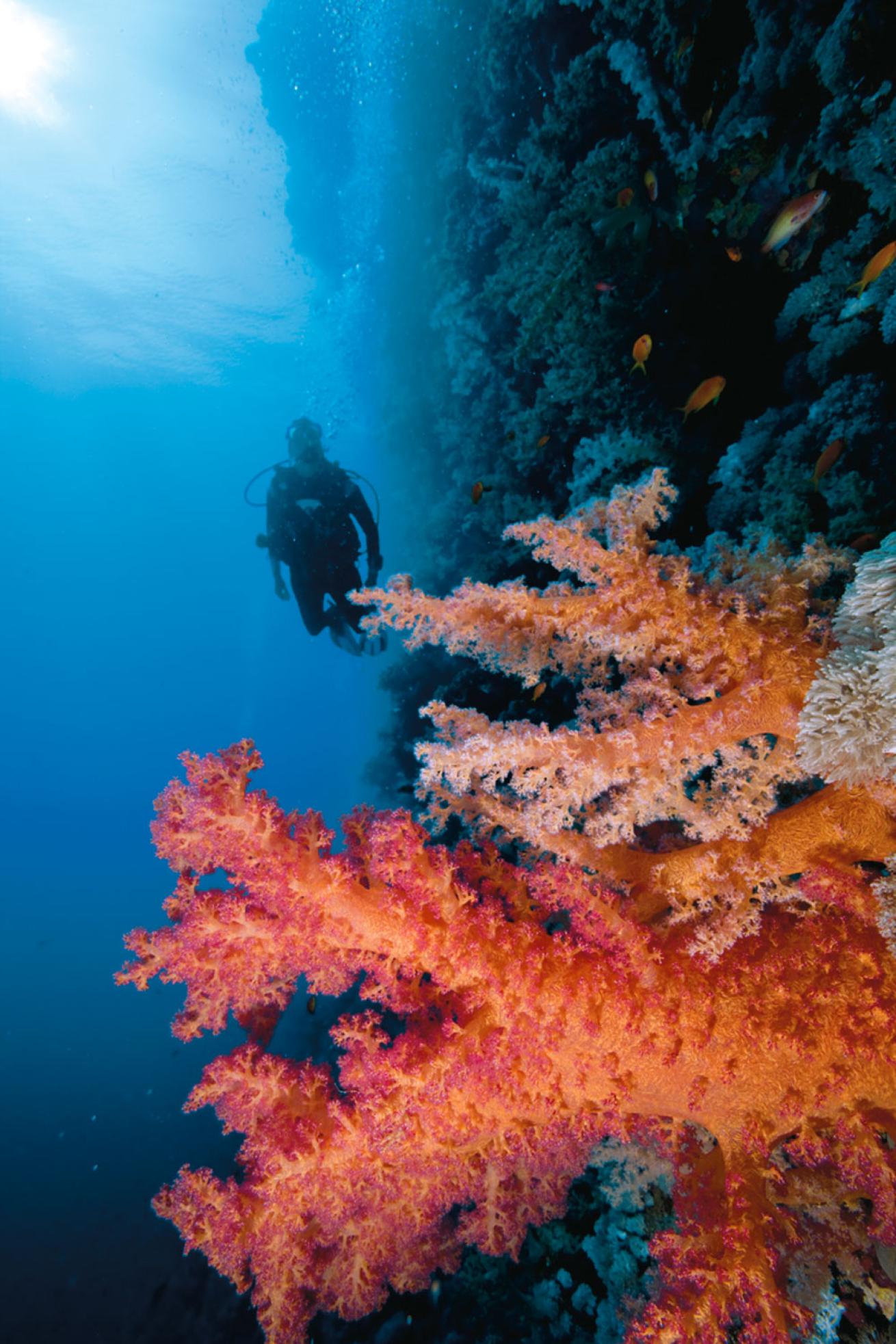
Stephen FrinkThe soft corals adorning the vertical precipice at Little Brother island provide the wide-angle vistas that so define the Red Sea experience.
The Brothers Islands
These spectacular islands, known in Arabic as El Akhawein, are accessible only by live-aboard and are subject to both wind and current. Because they're exposed to current-swept nutrients, Big Brother (marked by a lighthouse) and Little Brother are magnificently draped in soft corals. In fact, the combination of crystalline blue water and soft coral concentrations makes the Brothers one of the world's best wide-angle studios. But it's not just about the reef scenics, for both islands present excellent opportunities for encounters with big pelagics and abundant reef fish.
We start off at Little Brother and find clear water and massive gorgonian fans decorating the vertical wall and reef slope down to 90 feet and beyond. Because of current, only the west side of the island is in the lee, but I have dived the east on a previous expedition and found it similarly remarkable. Some of the divers followed a deeper profile and are rewarded with a school of 12 hammerheads at 120 feet. After three dives at Little Brother, we move to our nighttime anchorage at Big Brother.
While this island offers plenty of vertical walls dripping with color and texture, its highlights are two shipwrecks lying along the deep slope of the wall. The Aida, the deeper of the two, sank in 1958. Technical divers can penetrate the wreck and explore her bow. Though recreational divers can see a bit of her at 100 to 120 feet, to really sample her treasures, you have to dive to at least 130 feet. That's too little time and too much nitrogen for me, and besides, the shallower Numidia is one of my all-time favorite wrecks.
The current is truly ripping on the Numidia. On days of heavy flow the only way to get to the wreck is to drop in from an inflatable boat up current, beat fins to 100 feet, and drift into the wreck. On our first drop we're put into the water down current, and there's no way we can fight our way back to the wreck. We drift to the wall and find spectacular wide-angle vistas.
On our second attempt the drop is fine, but the current is still so swift we have to dump air from our BCs and swim straight to the depths. Even so, I barely avoid being swept past the wreck by catching the upright mast and make my way to the lee of the deck. Compared to my last visit, she's not nearly as encrusted with soft corals, maybe as the result of a big storm. She's still a great dive, but not the jaw-dropping confluence of crimson soft corals and schools of orange anthias that I remember from earlier visits. Still, she's a must-dive at the Brothers, and eminently worthy of exploration.
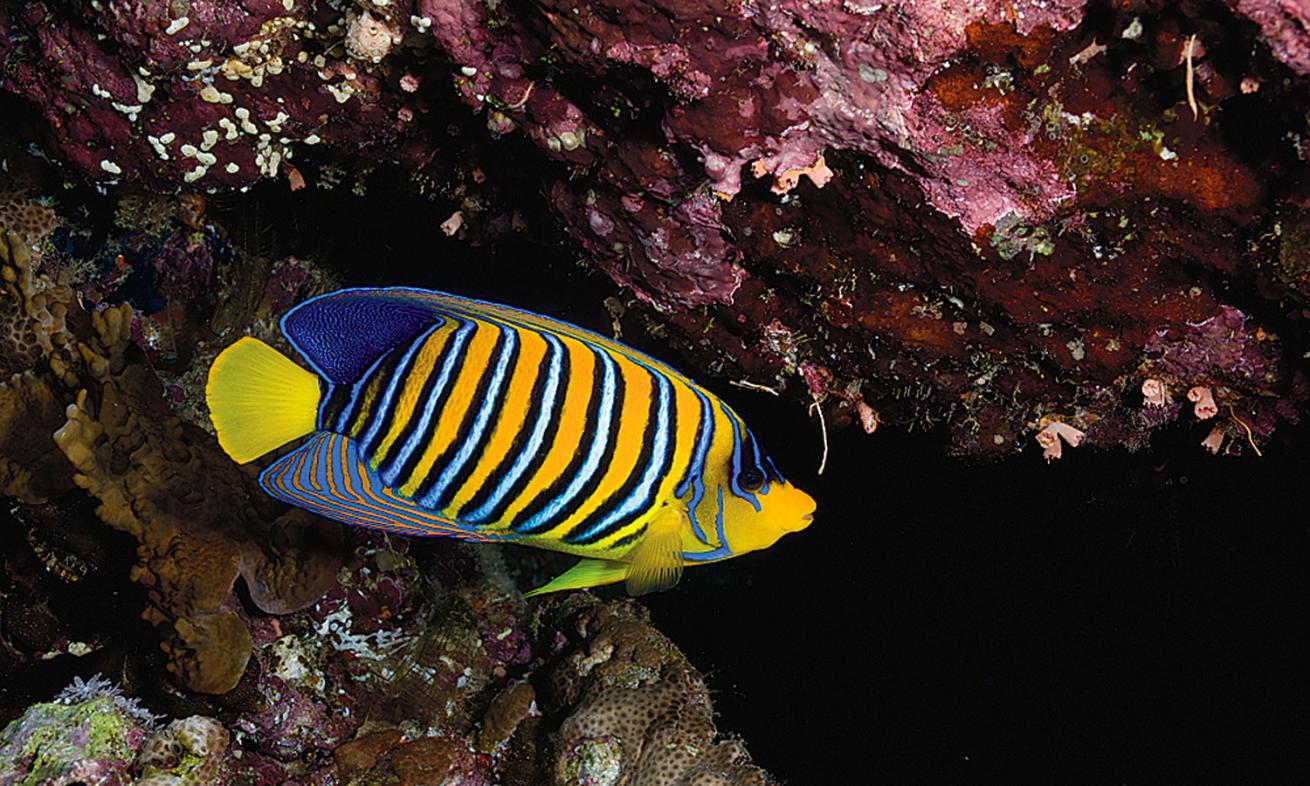
Stephen FrinkRegal Angelfish
Daedalus Reef
This massive offshore island is the final gem in the Red Sea's offshore Triple Crown. It's slightly exposed at low tide and marked by a large lighthouse that's open to live-aboard guests.
Daedalus Reef is so big it's really a series of four or more distinct dives. In fact, we do seven dives here and never exhaust the possibilities. The boats moor seaward of the lighthouse dock, along the island's east side. A short dinghy ride brings us to the northwest end of the island. You can dive deep here, to 120 feet, where deep-water currents often attract hammerheads and even thresher sharks. We stick to the shallows where there are pristine hard corals dotting the drop-off, from 10 feet to 80 feet, and a unique pinnacle with a large mass of opal sweepers at the 80-foot mark.
Our second dive is off the southwest end of the island at Anemone City, which has a large concentration of anemone clusters, all with crimson mantles and occupied by large numbers of two-band anemonefish or Red Sea clownfish. The shallowest, and probably largest, cluster of anemones is in only 20 feet of water, and they punctuate the wall down to about 60 feet, enough anemones to occupy even our large group of active photographers.
On the boat during lunch we see several oceanic white-tips and a school of bottlenose dolphins swimming past. An oceanic white-tip also puts on a spectacular show during our overnight stay here as he zooms to the back of the boat to scoop up the shark-friendly detritus discarded from our evening meal.
Other highlights of Daedalus include a massive mushroom coral, at least three stories tall. Aside from the crowds of clownfish, you'll also see lots of hawksbill turtles. We see three or four every time we dive along the south face of the island.
Northern Itinerary
By Mark Evans
The northern Red Sea isn't renowned for its dramatic walls (apart from Ras Mohammed), pelagic sightings and ripping currents, but what the north does have is wrecks--and what wrecks they are. I recently took a group of first-time Red Sea divers on a live-aboard's northern itinerary, taking in the Thistlegorm, the Rosalie Moller and Ras Mohammed, all world-class sites. We flew into Hurghada, and then boarded an air-conditioned mini-bus to our home for the week, the 135-foot Blue Horizon.
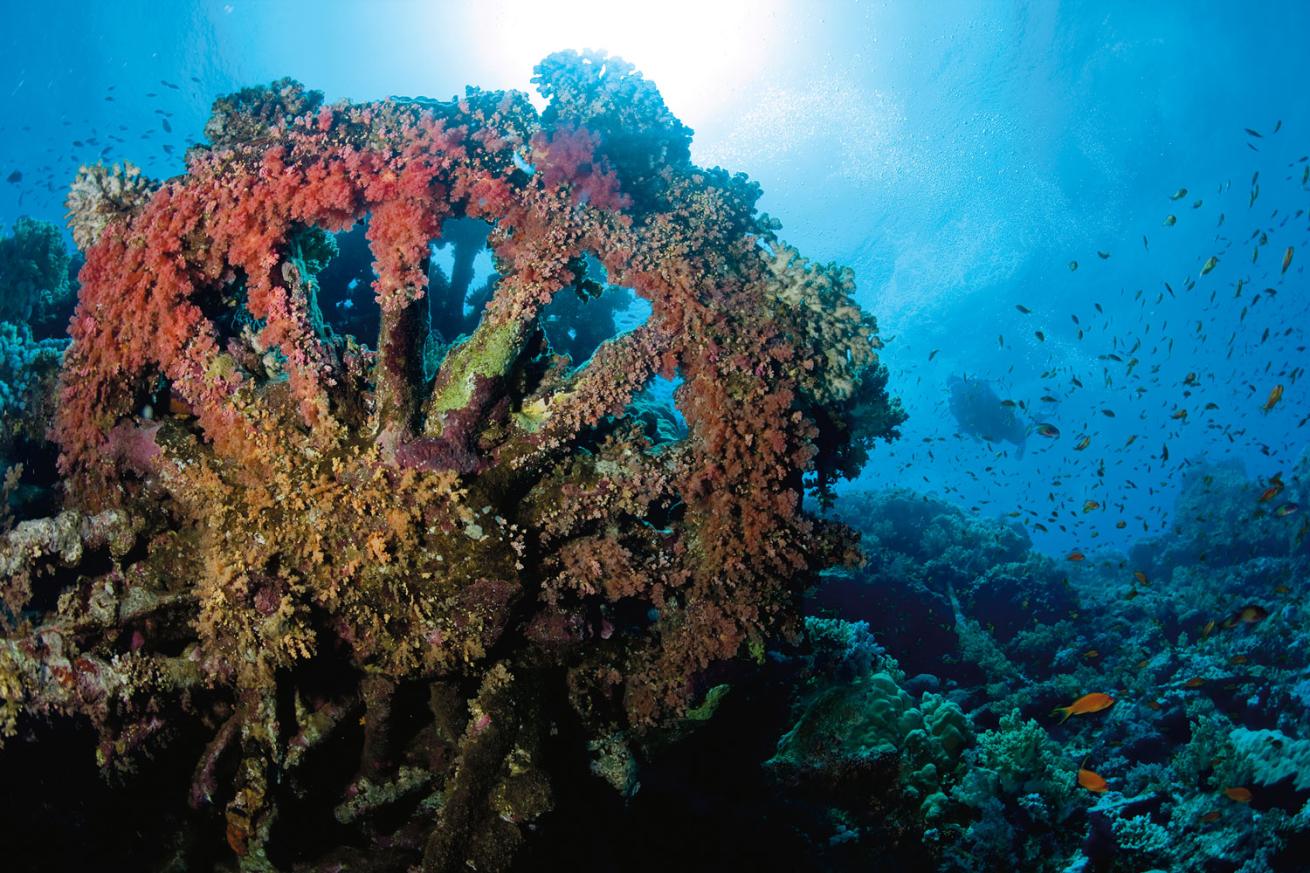
Stephen FrinkThe Numidia ran aground on Big Brother island in 1901, and while most of the wreck lies along the deep slope at 80 feet and beyond, a set of spoked wheels from a large deck wagon remains embedded in the shallows at only 20 feet.
The Rosalie Moller
First up on this trip is one of my all-time favorites, the Rosalie Moller, a 360-foot cargo vessel that was carrying Welsh coal when she was sunk by German bombers in 1941. She sits upright in 170 feet of generally murky water, and is basically intact with portholes in place. The Rosalie is an awesome dive by anyone's standards. The deck doesn't start until 100 to 105 feet, making this a dive for experienced divers, but those comfortable with dropping down a line in only 30 to 35 feet of vis are rewarded with a large wreck absolutely smothered in marine life. Silversides and glassfish swarm over the superstructure, often in such huge numbers they limit the visibility even further. Lionfish, trevally, jacks and tuna are also living life to the full on this veritable smorgasbord of food. Even using nitrox, time is limited here, but what time you do have on her is well worth the effort. This really is a full-on dive, and one hell of an intro to the Red Sea's wrecks.
The Thistlegorm
This ship, one of the world's most famous wrecks, was first discovered by the legendary Jacques-Yves Cousteau in 1956, 15 years after it was sunk by German bombers. The massive cargo vessel then lay untouched until the early 1990s, when it was rediscovered and became the jewel in the northern Red Sea's crown.
This is a large, impressive wreck — 423 feet long — but what makes her so appealing to divers is the depth. She sits in just 105 feet of water and reaches to within 50 feet, so you get plenty of bottom time to explore the valuable cargo of military hardware contained in her holds.
The Thistlegorm is an underwater museum with armored cars, Bedford trucks, BSA motorcycles, mobile generators, airplane wings, Lee Enfield rifles, rubber boots and hundreds of rounds of .303 ammunition inside the cavernous interior. On the deck you'll see coal trucks and water tenders that were for the two locomotives that were onboard. The massive explosion that tore the wreck in two was so powerful it blew the main engines into the air, and they landed on either side of the vessel. They now sit on the seabed upright — perfect props for photographers. Bren carriers, massive shells and boxes of smaller munitions, as well as the drive shaft, cleanly sheared off from the stern, are in the debris field between the two intact sections of the wreck.
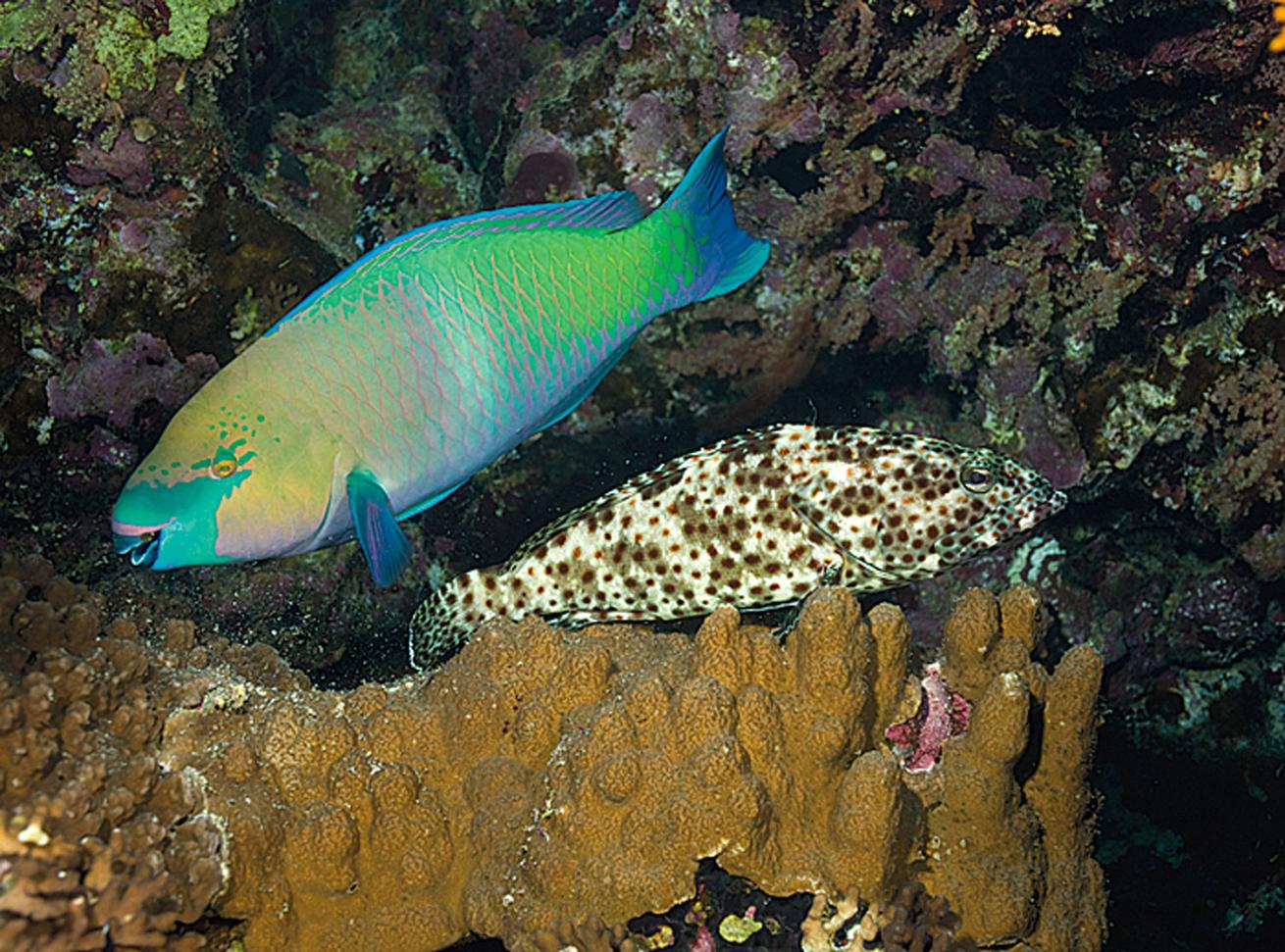
Stephen FrinkRusty Parrotfish & Greasy Grouper
Everything on board is slowly succumbing to the decades she has spent on the seabed, but the Thistlegorm is still an amazing sight to behold. Divers who have been exploring her for many years might be dismayed at her current condition, but for first-timers, she still has the ability to take their breath away. We complete three dives on her, including one at night, and many in the group immediately named her their best-ever wreck dive.
Kingston
We follow the dives on the Thistlegorm with one on a much older wreck, the SS Kingston. This steam-powered cargo ship ran aground on Shag Rock in 1881 and is now an integral part of the reef. The stern section is still intact, but after 10 minutes or so, you can thoroughly explore all there is to see, and then drift along the reef. This shallow system is predominantly made up of hard corals, with outcrops of soft corals, and it's home to all the usual Red Sea reef dwellers, in particular large shoals of yellow snapper and fusiliers. This pretty reef is popular, but next on our itinerary is another biggie — Shark and Yolanda Reefs in Ras Mohammed National Marine Park.
Ras Mohammed National Marine Park
Jacques-Yves Cousteau named Shark Reef one of his top 10 dives in the world, and its dramatic sheer wall is simply awe-inspiring. Hit it in July — as we did — and you are rewarded by huge shoals of bohar snapper, batfish, jacks, unicornfish and barracuda, which will allow you to approach very close. This swirling mass of marine life can bring in the predators, and we have a brief, but memorable, encounter with a solitary hammerhead shark. Previously, I have spent time out in the blue with hunting black-tip sharks as well. Even tiger sharks have been sighted on Shark Reef in recent years.
Even without the sharks or the large shoals, the impressive soft coral growth on the wall and in the saddle between Shark and Yolanda is enough to keep any diver busy, with its wide-ranging array of Red Sea reef species.
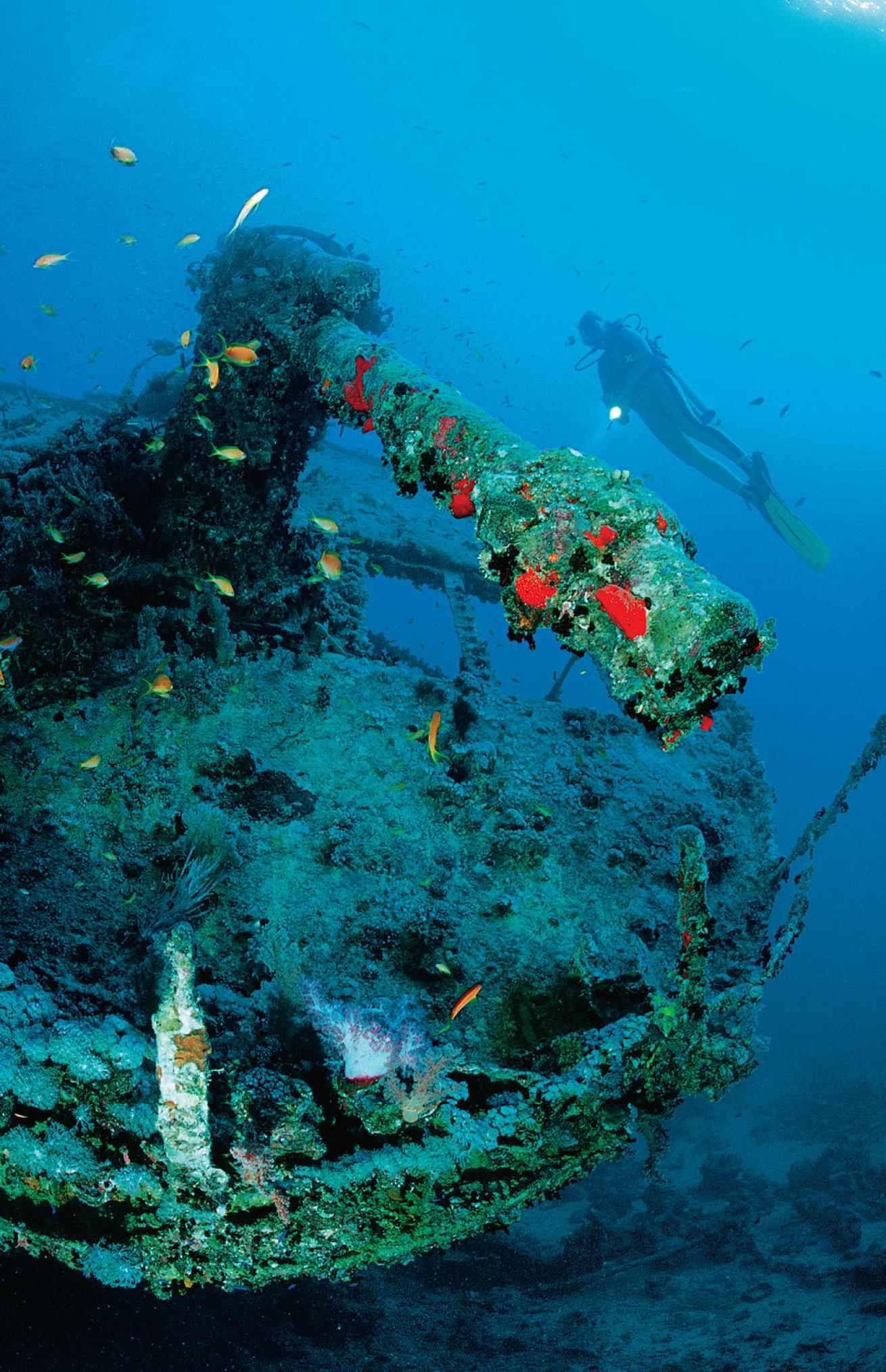
Reinhard DirscherlArrive early to avoid the crowds diving the Thistlegorm.
Yolanda Reef is named after a Cypriot cargo ship that ran aground in 1980 and then sank in stormy conditions. The vessel has since slipped into the abyss and lies in 650 feet of water, but its cargo of bathroom fixtures is in the shallows — toilets, bath tubs, rolls of linoleum and shower curtains have all been absorbed into the reef, and are smothered in marine growth. Even the captain's BMW is here, though the twisted mass is hard to make out as a car, save for a couple of wheels and tires and the clutch and brake pedals.
This site can be subject to some strong currents, making it best suited to more experienced divers, but it's simply one of the world's best wall dives.
Dunraven & Sha'ab Abu Nuhas Wrecks
We round out the week with three more wrecks, the Dunraven, Giannis D and Carnatic. The Dunraven, like the Kingston, was a steam-powered sailing vessel that ran aground in 1876, and it ended up nestled upside down on a sloping reef. The stern sits in 90 feet and the bow in 50 feet, and it's possible to swim virtually the entire length of the vessel inside the upturned hull, save for a section that has collapsed near the midships. There's plenty of light penetration, so a light isn't necessary, but it's worth taking one with you to pick out the prop shaft, boilers and engine workings.
Next we travel to Sha'ab Abu Nuhas, home of four of the Red Sea's most popular dives, the Kimon M, Giannis D, Carnatic and the Marcus/Chrisoula K. Our plan is to dive the latter three, but less-than-ideal weather conditions mean we have to settle for dives on the Giannis D and Carnatic.
The Giannis D was a Greek cargo ship that ran aground in 1983 and now lies running up a sloping reef from 75 to 80 feet at the stern and 50 feet at the bow. The midships is completely destroyed, twisted and shattered by years of strong tide and wave action, but the large stern is pretty much intact, offering plenty of penetration routes through the bridge, crew's quarters and into the engine room. The superstructure of the Giannis D reaches up to within 15 feet of the surface, so it's possible to conduct a lengthy multilevel dive and finish up doing your safety stop still exploring the wreck.
The final wreck of the trip is the Carnatic. This steam-powered sailing ship ran aground on Abu Nuhas in 1869 and subsequently broke in two, taking 27 passengers and crew to the seabed with her. Amazingly, both sections of the wreck ended up next to each other. Much of the decking has rotted away, leaving the coral-encrusted metal hull and main structure, which is by far the most photogenic in the northern Red Sea.
For North American divers, the distance to the Red Sea and cost to travel there can be prohibitive — but whether you choose a northern or southern itinerary, the diving is well worth it.
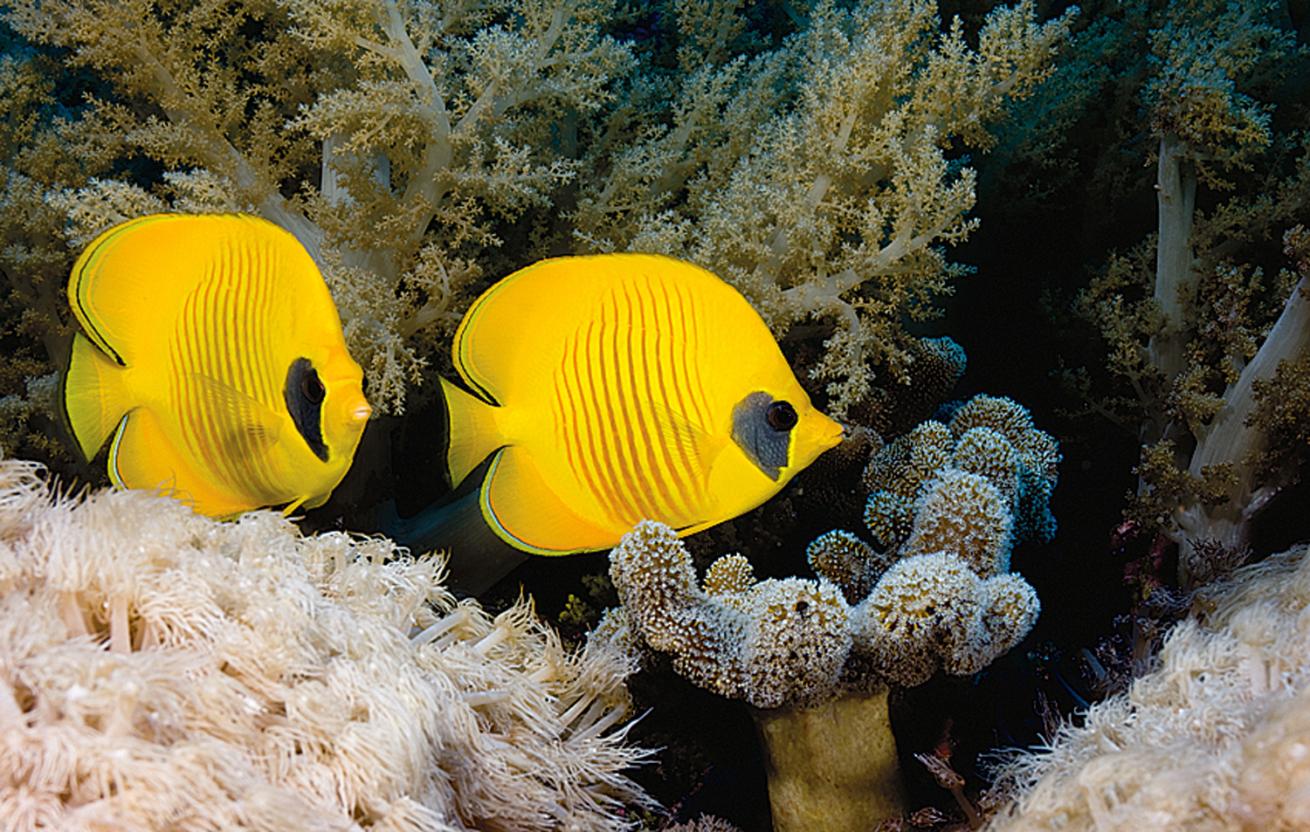
Stephen FrinkBlue-cheek Butterflyfish
One Fish, Two Fish, 1,100 Fish ...
If you're used to the fish typically found on Caribbean reefs, you'll be blown away by the species and sheer numbers of Indo-Pacfic fish found on every reef, seamount and wreck in the Red Sea. More than 1,100 species are found here (about 10 percent of these are endemic).
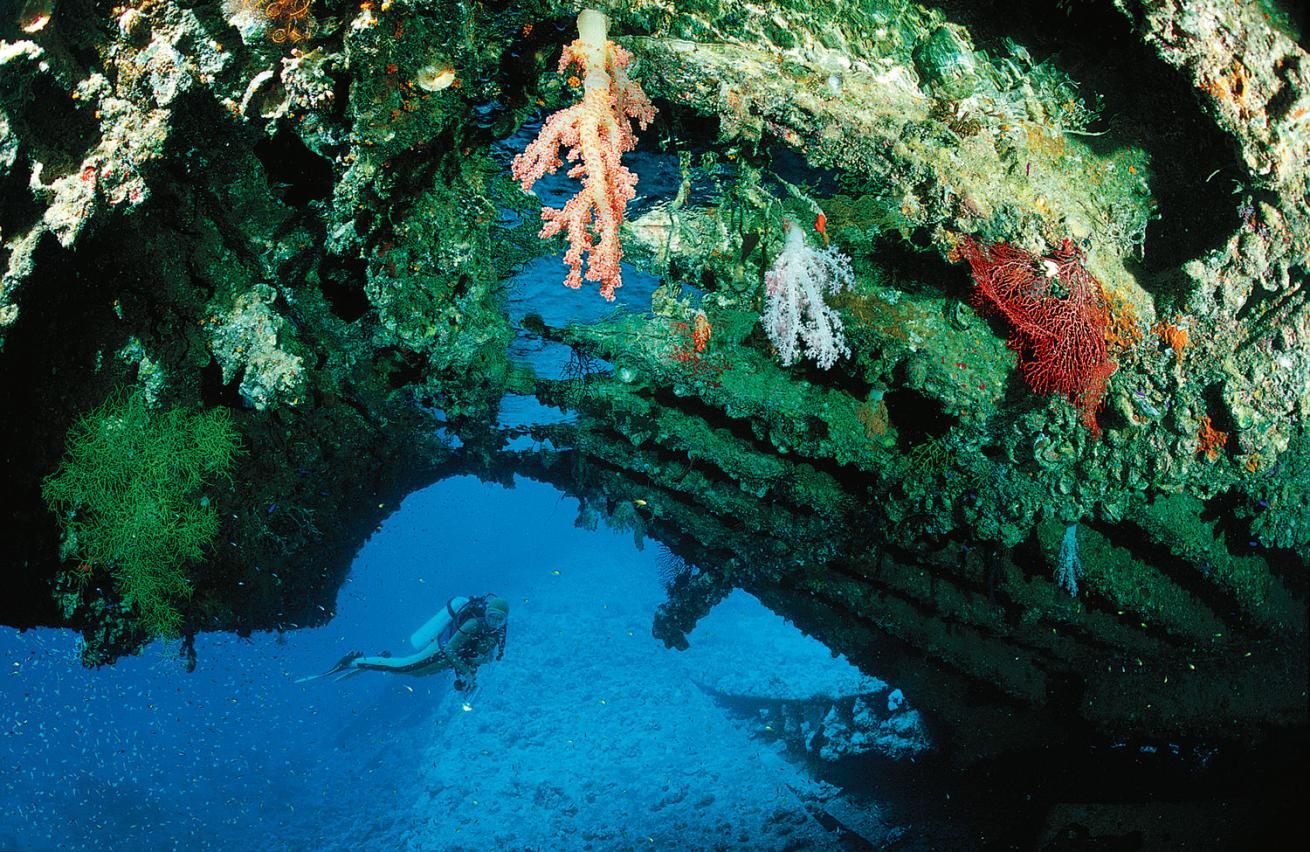
Reinhard DirscherlBroken in two, the coral-encrusted British steamer Dunraven sits upside down on the reef with sections of it open to penetration.
Visiting the Red Sea
The Red Sea is never going to attract divers from the U.S. in as large numbers as it does from the UK and other European countries. But those American divers who do make the trip across the Pond are going to be shouting about it once they get home. The diving is well worth the effort to get to Egypt (for more on how to get to the Red Sea from North America, see In Depth, p. 89, section 2). Add in the fun and adventure of the Middle Eastern experience--visiting the Pyramids, sampling shisha (fruit-flavored tobacco smoked through a water pipe) and taking a camel ride--the Red Sea has a lot to offer divers of all levels, whatever their nationality.
InDepth
Getting There: For North Americans, UK tour operators take the hassle out of planning a Red Sea trip, negotiating discounts with hotels, live-aboard and land-based dive operators, and airlines. You'll most likely fly into one of London's airports, either Heathrow (LHR) or Gatwick (LGW), and then board a connecting flight to Egypt. Flights from London to Egypt depart from Gatwick, so you'll either fly into Gatwick from the U.S., or into Heathrow and take a shuttle bus to Gatwick. From London, nonstop flights are available to Hurghada (HRG), Sharm-el-Sheikh (SSH) and Marsa Alam (RMF). Flying nonstop from New York to Cairo (CAI) is a good option if you've planned an add-on excursion to Cairo, the Nile River or pyramids. For a list of Egyptian tour operators, go to touregypt.net.
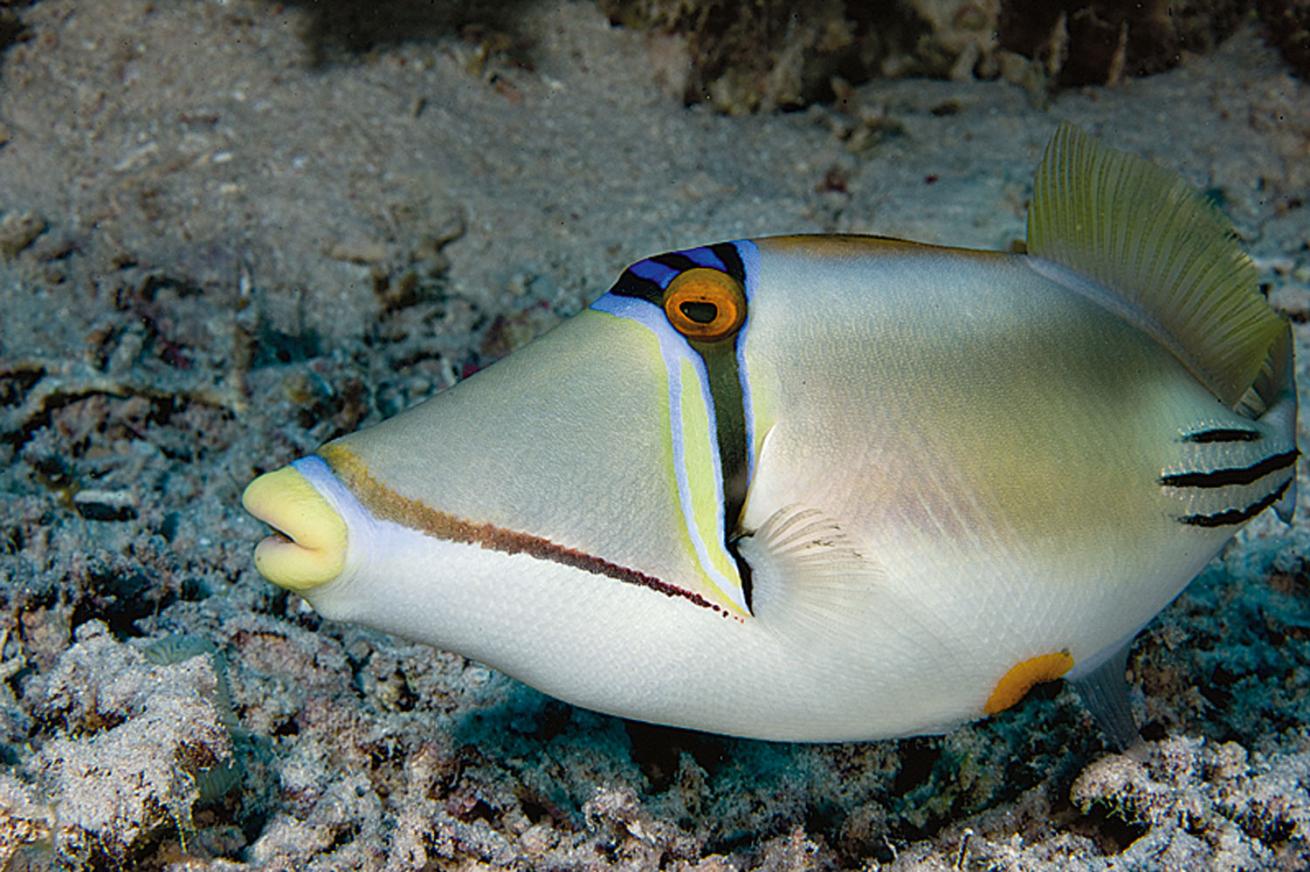
Stephen FrinkArabian Picassofish
Entry Documents: A passport valid for six months from your date of return and a 30-day tourist visa are required. To get one before your trip, contact the Egyptian Embassy in Washington, D.C. (egyptembassy.net) or the Egyptian Consulate nearest you (http://www.usembassy.gov/. It is possible for U.S. citizens to obtain a visa at any of the Egyptian ports of entry.
Operators: Red Sea Aggressor.
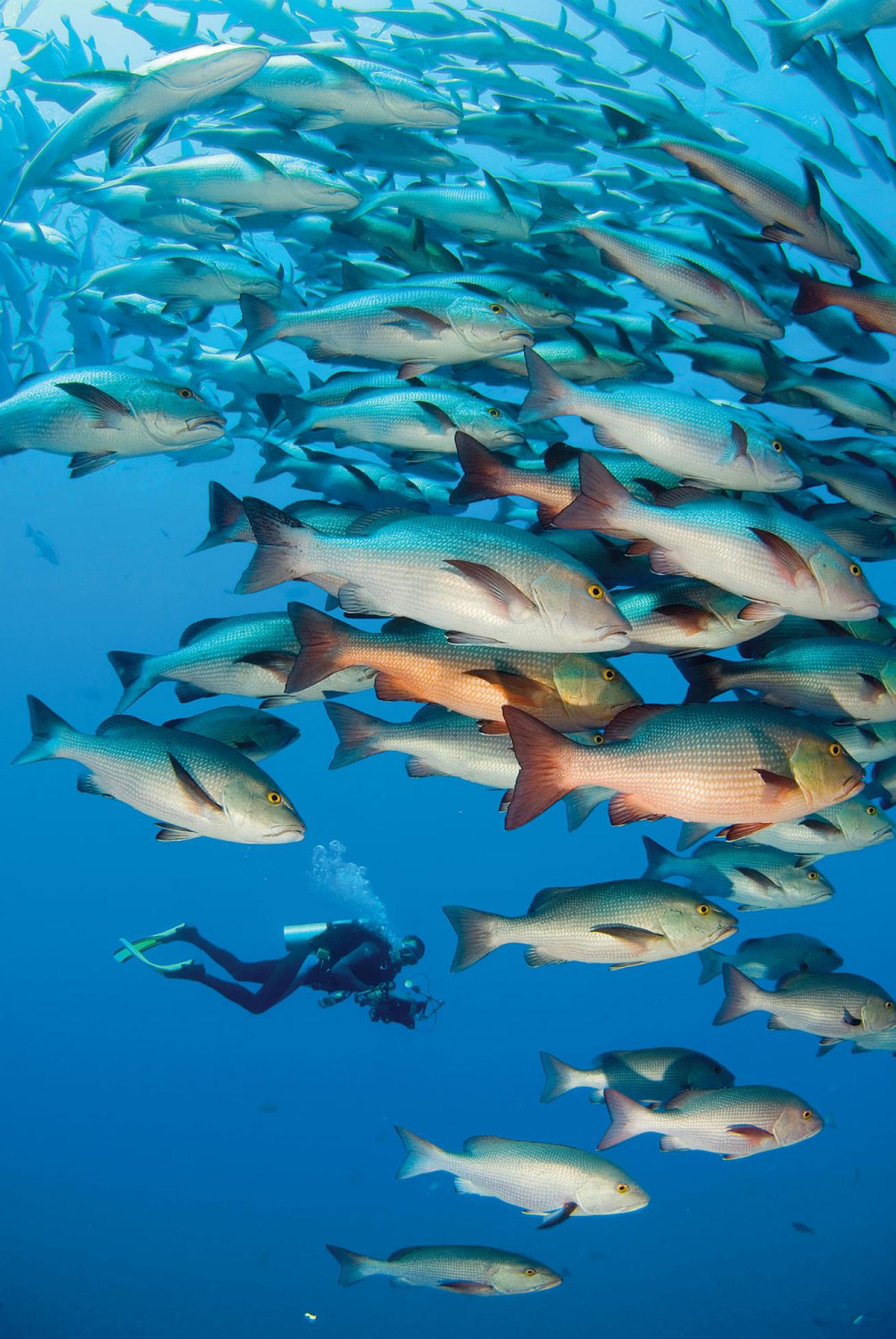
Martin StrmiskaA school of bohar snappers at Yolanda Reef
Climate & Water Conditions: Egypt has two main seasons: a mild winter from November to April and a hot summer from May to October. In the coastal regions, average air temperatures range from the 60s to 100 degrees or more in summer. Water temps range from the low 70s in winter to the low 80s in summer. Visibility is consistently stellar, around 100 feet, except during occasional plankton blooms. The water tends to be choppy, and count on drift diving on exposed seamounts and pinnacles. The dive season is year-round. Late spring and fall are good months to plan your trip, but the big pelagics are around in July and August.
Money Matters: Currency is the Egyptian pound (EGP). Generally, tip the live-aboard crew at the end of the week, roughly 10 percent of the cost of the charter. If you're spending any time on the Egyptian mainland, tipping — or what is known as baksheesh — is common. Tip taxi drivers only when he has rendered a service you find helpful. Porters and others should be tipped when bags are carried or room service is delivered. Carry a few one pound notes (Egyptian) at all times.
U.S. Safety: Check the U.S. Department of State web site at travel.state.gov for the most up-to-date travel warnings.


